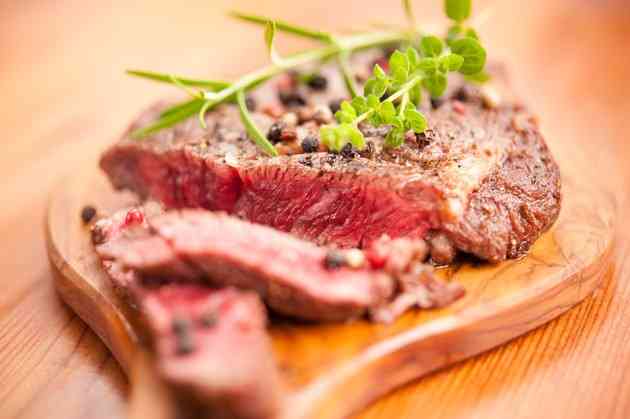How to Age a Steak With Salt

The purpose of aging beef is to improve tenderness and enhance flavor. Aging gives the natural enzymes time to break down the muscle and connective tissue, which tenderizes the meat. Moisture loss during the process concentrates the flavor to create the unique taste associated with aged beef. Technically, salt isn't used to age beef, but it is used to dry or cure the meat.
 A grilled rib-eye steak on a wooden cutting board. (Image: The_Pixeltree/iStock/Getty Images)
A grilled rib-eye steak on a wooden cutting board. (Image: The_Pixeltree/iStock/Getty Images)Choosing the Meat
The aging process isn't a cure for less tender cuts of beef, so choose fresh cuts of prime or choice grade rib-eye, beef loin or beef round. Meat for aging should have a thick layer of fat on the outside because it protects the meat, and it should have slivers of fat running throughout the cut. It's best to use a whole rib-eye or loin strip and cut it into individual steaks after it's dry-aged. If you're drying beef with salt, top or bottom round is fine and you don't need extra fat on the meat.
Dry-Aging Beef
Wrap the meat in plain white cotton dish towels and put it on the bottom shelf of the refrigerator or in the coldest compartment. Change the towels every day until the meat is aged, which should take 10 to 21 days, but varies according to the size of the meat, according to the website Ask the Meatman. A crust that's similar in texture to beef jerky forms on the outside of the meat during the process, so watch for it as a sign that the aging is complete. Then trim the crust away and it's ready to cook.
Dry-Aging Considerations
To get the best results, the temperature should be maintained at 34 to 36 degrees Fahrenheit. The beef can pick up odors from the refrigerator, so be careful to keep foods properly covered. If you age the meat too long, microorganisms can grow and cause spoilage. In addition to an unpleasant odor, the sign of spoiled meat is a slimy surface. It's normal for the meat to shrink during aging, so the end product will have less edible meat.
Dried Beef
Remove any fat around the edges of a round steak, thinly slice it, then put the slices into brine made with 10 cups of near boiling water and two pounds of salt. Leave the meat in the brine until it turns white, then put the strips directly onto the wire rack in your oven with a tray or aluminum foil on the rack underneath to catch drips. Dry it at 225 degrees Fahrenheit, keeping the oven door slightly open so that moisture escapes. The amount of time it needs in the oven depends on the meat's thickness, but plan for four to six hours, and turn the beef over about halfway through. It's finished when it bends but doesn't break. If desired, you can flavor the brine with pepper, soy or Worcestershire sauce, onion or garlic powder or liquid smoke.
Salt-Cured Beef
Salt preserves meat by pulling water out of the cells and that prevents microorganisms from growing. Mix together eight pounds of salt, three pounds of sugar, two ounces of sodium nitrate and one-half ounce of sodium nitrite. Divide the mixture into thirds and rub one-third of it over the meat every three to five days. Keep the meat in the refrigerator seven days for every one inch of the meat's thickness.




